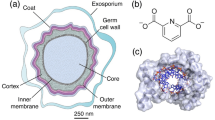Abstract
The emergence of Bacillus anthracis as a potential bioterrorism and biological warfare agent points to the need for safe, effective, and economical sporicides for infection prevention and control. This work examined the efficacy of iodine vapor decontamination technologies to inactivate a surrogate for B. anthracis, Bacillus thuringiensis spores on glass materials. 106–107 colony-forming units of spores inoculated onto circular glass cover slips were treated with different concentrations of iodine vapor under various temperature and relative humidity. Only minimal spore killing activity was observed at low humidity. Higher humidity levels, as well as pre-hydration or post-hydration of the spores, increased the rate of inactivation as long as the contact between spores and iodine was maintained in a hydrated environment. Significant sporicidal activity of 3-log and 6-log spore reduction has been observed with 2.1 mg L−1 iodine vapor concentration at 90% relative humidity and 22 °C, with 1 and 24 h of exposure, respectively. The results showed that the relative humidity of the environment is of major importance in regulating the rate at which the spores are inactivated by iodine. The results of this study may provide insight into the parameters of effective decontamination procedures for Bacillus spores using gaseous iodine.








Similar content being viewed by others
References
American Public Health Association, American Water Works Association, Water Environment Federation (1998) Standard methods for the examination of water and wastewater. APHA–AWWA–WEF, Washington
Aydogan A, Gurol MD (2006) Application of gaseous ozone for inactivation of Bacillus subtilis spores. J Air Waste Manag Assoc 56(2):179–185
Bloomfield SF, Arthur M (1994) Mechanisms of inactivation and resistance of spores to chemical biocides. Soc Appl Bacteriol Symp Ser 23:91S–104S
Bloomfield SF, Megid R (1994) Interaction of iodine with Bacillus subtilis spores and spore forms. J Appl Bacteriol 76(5):492–499. doi:10.1111/j.1365-2672.1994.tb01107.x
Carrera M, Zandomeni RO, Fitzgibbon J, Sagripanti JL (2007) Difference between the spore sizes of Bacillus anthracis and other Bacillus species. J Appl Microbiol 102(2):303–312. doi:10.1111/j.1365-2672.2006.03111.x
Chang SL (1971) Modern concept of disinfection. J Sanit Eng Div 97(5):689–707
Clark BR, Pantoya ML (2010) The aluminium and iodine pentoxide reaction for the destruction of spore forming bacteria. Phys Chem Chem Phys 12(39):12653–12657. doi:10.1039/c0cp00473a
Cornelius W, Krusé MA, Hsu Yu-Chi, Griffiths Annabel C., Stringer Richard (1970) Halogen action on bacteria, viruses and protozoa. In: National specialty conference on disinfection. Amherst, Massachusetts, July 8–10 1970. ASCE, New York, pp 113–136
Gilbert GL, Gambill VM, Spiner DR, Hoffman RK, Phillips CR (1964) Effect of moisture on ethylene oxide sterilization. Appl Microbiol 12:496–503
Gorman SP, Scott EM, Hutchinson EP (1985) Effects of aqueous and alcoholic povidone-iodine on spores of Bacillus subtilis. J Appl Bacteriol 59(1):99–105. doi:10.1111/j.1365-2672.1985.tb01780.x
Gottardi W (1985) The influence of the chemical behaviour of iodine on the germicidal action of disinfectant solutions containing iodine. J Hosp Infect 6:1–11
Gottardi W (1999) Iodine and disinfection: theoretical study on mode of action, efficiency, stability, and analytical aspects in the aqueous system. Arch Pharm 332(5):151–157. doi:10.1002/(SICI)1521-4184(19995)332:5<151::AID-ARDP151>3.0.CO;2-E
Gould GW (1977) Recent advances in the understanding of resistance and dormancy in bacterial spores. J Appl Bacteriol 42(3):297–309
Hoffman RK (1968) Effect of bacterial cell moisture on the sporicidal activity of beta-propiolactone vapor. Appl Microbiol 16(4):641–644
Hoffman RK, Spiner DR (1970) Effect of relative humidity on the penetrability and sporicidal activity of formaldehyde. Appl Microbiol 20(4):616–619
Houang ET, Gilmore OJ, Reid C, Shaw EJ (1976) Absence of bacterial resistance to povidone iodine. J Clin Pathol 29(8):752–755. doi:10.1136/jcp.29.8.752
Koch R (1881) Uber disinfektion. Mitteilungen aus dem Kaiserlichen Gesundheitsamte. Struck, Berlin
Miyata S, Kozuka S, Yasuda Y, Chen Y, Moriyama R, Tochikubo K, Makino S (1997) Localization of germination-specific spore-lytic enzymes in Clostridium perfringens S40 spores detected by immunoelectron microscopy. FEMS Microbiol Lett 152(2):243–247. doi:10.1111/j.1574-6968.1997.tb10434.x
Rice EW, Adcock NJ, Sivaganesan M, Rose LJ (2005) Inactivation of spores of Bacillus anthracis Sterne, Bacillus cereus, and Bacillus thuringiensis subsp. israelensis by chlorination. Appl Environ Microbiol 71(9):5587–5589. doi:10.1128/AEM.71.9.5587-5589.2005
Russell AD (1990) Bacterial spores and chemical sporicidal agents. Clin Microbiol Rev 3(2):99–119. doi:10.1128/cmr.3.2.99
Russell AD (1999) Bacterial resistance to disinfectants: present knowledge and future problems. J Hosp Infect 43:S57–S68. doi:10.1016/S0195-6701(99)90066-X
Russell R, Bless S, Blinkova A, Chen T (2012) Sporicidal effects of iodine-oxide thermite reaction products. Shock Compress Condens Matter 1426:157. doi:10.1063/1.3686244
Sagripanti JL, Bonifacino A (1996) Comparative sporicidal effects of liquid chemical agents. Appl Environ Microbiol 62(2):545–551
Schmitt K, Zacchia NA (2012) Total decontamination cost of the anthrax letter attacks. Biosecur Bioterror 10(1):98–107. doi:10.1089/bsp.2010.0053
Smyth HF, Pike EF (1923) A suggested new method for the disinfection of hides and skins for anthrax. Am J Epidemiol 3(3):224–237
Tennen R, Setlow B, Davis KL, Loshon CA, Setlow P (2000) Mechanisms of killing of spores of Bacillus subtilis by iodine, glutaraldehyde and nitrous acid. J Appl Microbiol 89(2):330–338. doi:10.1046/j.1365-2672.2000.01114.x
Tisa LS, Koshikawa T, Gerhardt P (1982) Wet and dry bacterial spore densities determined by buoyant sedimentation. Appl Environ Microbiol 43(6):1307–1310
Westphal AJ, Price PB, Leighton TJ, Wheeler KE (2003) Kinetics of size changes of individual Bacillus thuringiensis spores in response to changes in relative humidity. Proc Natl Acad Sci USA 100(6):3461–3466. doi:10.1073/pnas.232710999
Willard CY (1938) Disinfection of anthrax infected hides with iodine. Graduate School of Arts and Sciences, University of Pennsylvania
Williams ND, Russell AD (1993) Revival of Bacillus subtilis spores from biocide-induced injury in the germination process. J Appl Bacteriol 75(1):76–81. doi:10.1111/j.1365-2672.1993.tb03411.x
Wilson RE (1921) Humidity control by means of sulfuric acid solutions, with critical compilation of vapor pressure data. J Ind Eng Chem 13(4):326–331. doi:10.1021/ie50136a022
Acknowledgements
This work was supported by DTRA Grant HDTRA1-11-1-0063. The authors thank Howie Joress for technical assistance.
Author information
Authors and Affiliations
Corresponding authors
Ethics declarations
Conflict of interest
The authors report no financial or other conflicts of interest relevant to the subject of this article.
Ethical Approval
Ethical approval is not required.
Rights and permissions
About this article
Cite this article
Jiang, X., Overdeep, K.R., Wainwright, E.R. et al. Effect of Humidity on Sporicidal Activity of Iodine Vapor on Bacillus thuringiensis . Curr Microbiol 75, 237–246 (2018). https://doi.org/10.1007/s00284-017-1371-2
Received:
Accepted:
Published:
Issue Date:
DOI: https://doi.org/10.1007/s00284-017-1371-2




